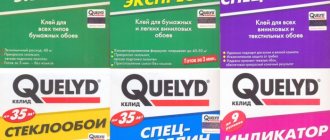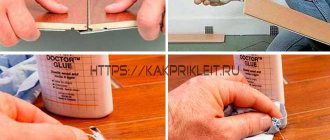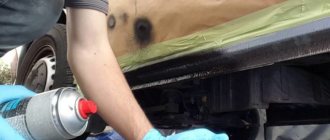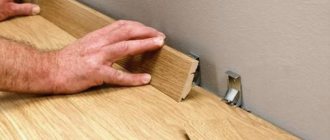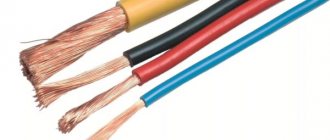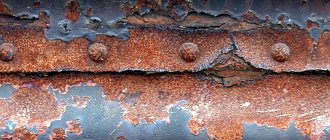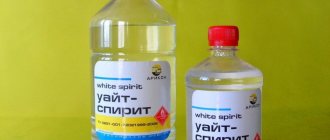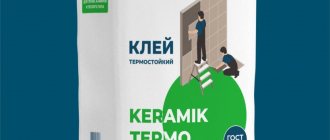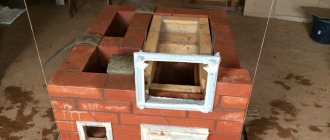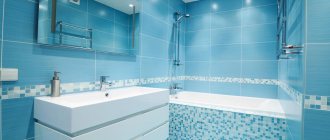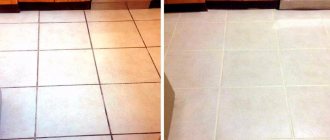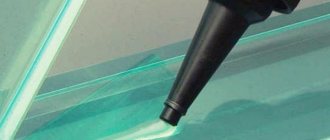Most of the things around us are made of plastic. And not all of them are durable; some can be quite fragile and break easily. To return such a product to its former appearance, you will have to try. Gluing two parts of a plastic object together is not so easy. The reason is that plastic has a special composition that cannot be joined with conventional glue. If special welding is used for plastic products in production, we cannot afford this in everyday life. Therefore, a special glue for plastic was created. But here everything is not so simple. Each type of plastic requires a certain type of glue, which has its own distinctive properties.
Types of glue for plastic
Since plastic products, unlike ceramics or metal, have a smooth surface, for this reason it is impossible to connect such parts together with ordinary glue. The product that connects such parts has a different composition, thanks to which it dissolves the synthetic polymers that make up the product, thereby connecting the parts. And now on store shelves you can find a large number of different glue options, which differ in composition and properties. And to better understand which product is right for you, you should understand the types of glue.
So, all products can be divided into four main categories. The most common is liquid glue. It has the simplest composition and is easy to use. But besides this, it should be taken into account that liquid glue can be water-based or contain a solvent. After applying such glue, the solvent or water present in the composition will gradually evaporate; at the end of this process, the product will be securely fixed. But it is impossible to use this option with sealed materials, since evaporation will not occur. Even after a long time, the glue will remain liquid and the parts will not bond. But since liquid adhesives will not attack plastic, they are usually used on small items that will not be subject to further stress. After application, the product should be left for one day so that the glue can dry completely.
The second product option for working with plastic products is contact adhesive. It can be with or without hardener. Here the glue is applied to the product, after which you need to wait about 10 minutes for the product to dry a little. After this, you need to press it tightly with another part, and this will cause gluing. This option can be used with products subject to load. But do not forget that contact adhesive is toxic and is not suitable for working with elastic types of plastic.
There is also a reaction type of glue. Here, products are bonded under certain conditions, for example, when interacting with oxygen in the air or the presence of ultraviolet radiation. Hence the name of the product. This option will provide greater reliability, the connection of the parts will be very strong, and even with physical impact, separation will not occur. This product may consist of one component or two. The first option is a liquid in a container. It just needs to be applied to the surface and connected to another object. This option includes adhesives that we used to call “Superglue”. The two-component option consists of two different containers containing the hardener and binder. Before use, they are mixed in a separate container, and then applied to the parts. After mixing, you can store them for about 30 minutes.
And the last option is hot melt glue. To use it you need a glue gun. It begins to exhibit its properties at a certain temperature. Each brand has its own. Hot melt adhesive is mostly used in handicrafts.
Epoxy resin
If something needs to be glued together for years, epoxy resin is the best option. And regardless of the brand chosen, each of them shows excellent gluing results. The hardeners contained in epoxy resin are resistant to all types of influence, including acids. Many craftsmen also make jewelry from epoxy resin. They place a flower or any other object in a mold and fill it with resin. The resulting pendant can faithfully serve its owner for many years.
How to choose the right glue for plastic
When a plastic item breaks, people usually don’t think twice and use universal or instant glue. This method is suitable for toys or repairing household items. But there are certain types of glue that are designed for special plastic. Therefore, a plastic product must be marked. For example, the Latin letters PP indicate that it is polypropylene, and PVC indicates polyvinyl chloride, PE means polyethylene. Such markings do not play a big role in solving everyday issues, but they are very important when it comes to automotive plastics. This way it will be clear which method should be used to carry out repair work.
In addition, the peculiarities of using the product to be glued should be taken into account. For example, for flexible plastics it is better to use the liquid version. Especially if the product will come into contact with water or bend. If parts must be stationary and subject to high loads, the best option would be to work with reactive glue.
A product containing a solvent should be used with great care. It is not suitable for all plastic products as it may completely ruin the item.
Cold welding Mastix MS 0115
Volume : 55 g.
Price : 67 rub.
Heat-resistant adhesive Cold welding Mastix MS 0115 is widely used in repair work. Many masters prefer it due to a number of advantages:
- for reliable fastening of parts;
- for quick drying;
- for flexibility to temperature conditions.
This adhesive is suitable for joints made of heat-resistant materials including plastics, ceramics and non-ferrous metals. Working with the composition is allowed under critical temperature conditions: from -60 to +250 degrees. As buyers say, Mastix MS 0115 is an irreplaceable thing for a motorist. Foreign heat-resistant analogues cost several times more, but they are glued in the same way.
Terms of use
Before starting the gluing process, the surface should be cleaned of dirt. It would be a good idea to degrease it with alcohol. To increase the bonding strength, you can walk over the surface with sandpaper. You don’t need to put in much effort, you just need to create some roughness, this will provide better grip. You should not apply a large amount of glue; it is not advisable for it to go beyond the work area. After this, you should gently but firmly squeeze the parts. If you are using a two-component product, mixing should be done before application.
Now let's talk about the rules for working with certain types of glue. When working with liquid glue, it should be applied to the surface of one object, then firmly connected to another, if necessary, use a weight for better fastening. Also, sometimes the product is applied to both products, wait for complete drying, and then perform the above procedure. This glue does not dry immediately, so during the process you can adjust the parts and install them in the desired position.
If you work with reactive one-component glue, then it must be applied to the surface of one part and immediately apply the second. The reaction here occurs very quickly, which is why it is also called second. If the work is to be done with a two-component product, then it should be mixed according to the proportions indicated on the packaging, after which it is applied to the two parts and they are connected.
When working with hot melt glue, you need to insert the glue rod into the gun and wait for it to heat up. After this, a portion of glue is applied to the parts and fastened together. You need to work here very quickly and carefully, since the glue hardens very quickly.
How to glue plastic tightly at home
Gluing plastic is not that difficult. Buy glue for plastic and follow our tips:
- Remove grease stains. Before you start gluing, degrease the work surfaces with a suitable detergent, alcohol or just soapy water. Dry or dry thoroughly. Do not touch the plastic with bare hands to avoid leaving oil stains.
- Sand the surface. For better adhesion of the glue, plastic surfaces must be slightly roughened. Sand the bonding area with sandpaper or sandpaper.
- Mix ingredients as needed. If you are using epoxy glue, you will need to mix the ingredients yourself in the correct proportions.
- Apply glue carefully. Apply glue to the plastic with a synthetic brush. For small details, use a toothpick or the tip of a needle. Try to apply the glue in a thin layer so that it does not spread when further squeezing.
Read the instructions carefully before starting work. Many types of plastic adhesives require the adhesive-coated surfaces to be pre-cured before pressing them, while others require them to be held at a specific temperature. The more carefully you follow the manufacturer's recommendations, the better the result will be.
- Press the pieces together. The reliability of the connection largely depends on the force with which the parts are pressed against each other. Try to do this with force, but not sharply, squeezing the parts strictly perpendicular to the surfaces being glued. Use clamps or rubber bands to hold the pieces until the glue is completely dry.
- Remove any remaining glue. Clean the glued parts from drops of glue using a special tool or any alcohol. Cyanoacrylate glue can be easily removed with acetone, but be careful not to damage the plastic.
The best superglue for plastic
Universal Moment Super Second
When you need to quickly fasten parts together, the “Super Second Moment” from . Since this model is universal, it can be used to fasten objects made of plastic, wood, ceramics, porcelain or rubber. It is also suitable for porous products that have highly absorbent properties. To do this, apply a thin layer of “Super Second Moment” to one of the surfaces of the part, after which another part should be immediately applied. Both parts must be squeezed tightly and held for several seconds. Immediately after this, the fastened items are ready for further use. It is better to work with gloves and a mask. Because if the product gets on the skin, it will instantly stick together. Super Second Moment should not be used on utensils that are used for eating or preparing food.
One tube contains 3 grams of glue.
The average cost is 55 rubles.
Universal Moment Super Second
Advantages:
- Instant grip;
- Suitable for any materials;
- Transparent seam;
- Price.
Flaws:
- Strong smell;
- Product remaining in the tube. Dries quickly.
Second super instant
This cyanoacrylate product is suitable for fastening parts made of any material. It is designed to work with leather, plastic, porcelain, metal, rubber, as well as cardboard. “Second Super Instant” is water resistant and suitable for both exterior and interior use. It will cope with its task in the temperature range from -30 to +50 degrees. And gluing will take only three seconds.
One tube contains 20 grams of the finished product, which is enough for a large amount of work. With the help of a convenient lid, you can easily save the remaining glue until the next need.
The average cost is 120 rubles.
Second super instant
Advantages:
- Volume;
- Dries in 3 seconds;
- Suitable for any materials.
Flaws:
- No.
Contact Super
If you need to quickly and reliably fasten parts, then “Super” glue will help with this. It is suitable for working with any materials. To do this, it should be applied in a thin layer to one of the parts, then fixed for a few seconds. Once the fixation has occurred, the parts must be left for 15 minutes to allow the components to harden. After this, the product can be used. The glued parts can withstand high loads, because the adhesive seam has a strength of 200 kgf/sq.cm. “Contact Super” can be used in the temperature range from -55 to +82 degrees.
A tube of “Contact Super” contains 20 grams of product.
The average cost is 250 rubles.
Contact Super
Advantages:
- Copes with its task;
- Large volume;
- Suitable for any materials;
- Operates over a wide temperature range.
Flaws:
- The price is significantly higher than similar products;
- After fixation, time is required for the components to cure.
Briefly about the main thing
When choosing how to glue PVC plastic together or with other materials, it is better to focus not on a promoted brand, but on real reviews and your own experience. And if it is not there, consult with the seller and pay attention to such points as purpose, release form, setting speed, method of application. Contact adhesive is usually inexpensive and is packaged in small containers, so you can buy several types at once and conduct your own tests.
Question
Write in the comments what you think - is it better to buy cheap Chinese glue or look for compounds from well-known manufacturers?
The best waterproof glue for plastic
Moment Crystal
This transparent adhesive is resistant to moisture, dilute acid and low temperatures. It can be used in construction and repair work, as well as in handicrafts. It can be used to glue metal parts, plastic products, including plexiglass, polystyrene, soft and hard PVC, and is also suitable for working with glass, rubber, cardboard and other materials.
When working with Moment Crystal, it is advisable that the room be ventilated and that there are no children or animals nearby. This is necessary due to the unpleasant odor this product has. You should also use gloves and a respiratory mask when working. Opened adhesive should be stored in a dry and warm place, away from fire and heating devices. Because it can easily ignite. Also, if the product was transported or stored in a cold place, you must wait until it “reaches” the ambient temperature before starting work. When using Moment Crystal, make sure that the products are dry and clean. After this, apply the product to both parts of the product, attach them to each other. After 15 minutes you need to squeeze them tightly. The glued item will be ready for use within a day.
The volume of “Moment Crystal” is 30 ml. Apply at a temperature not lower than +18 degrees.
The average cost is 90 rubles.
Moment Crystal
Advantages:
- Resistant to frost, moisture and diluted acids;
- Works with any materials;
- Convenient tube;
- Price.
Flaws:
- After opening it dries quickly.
UNU Creative
"UNU Creative" is a two-component epoxy adhesive. It is suitable for working with any materials, including plastic, glass, wood, rubber, concrete, etc. The adhesive joint will be completely transparent, and it is also resistant to stress and exposure to water and ultraviolet rays. Will be an excellent helper in needlework. It has the ability to fill holes and recesses, so it can be used to fasten parts that have an uneven surface.
Before work, the surfaces to be bonded should be cleaned and degreased. When working with metal, it will need to be sanded. After this, you should start mixing the glue. This can be done in the cup included in the kit or use a glass plate. Both components must be in equal quantities. You should mix thoroughly; the better the components are mixed, the better the gluing will be. Once the mixture is ready, it will need to be applied to objects and pressed against each other. Leave it like this for 30 minutes. After an hour, the product will be ready for use, but the complete drying process lasts about 12 hours.
The package consists of two 15 ml tubes.
The average cost is 485 rubles.
UNU Creative
Advantages:
- Reliably glues;
- Suitable for any materials;
- Resistant to water, frost, acid and alkali;
- The ability to add additional materials to the glue (sawdust, wood flour) and expand its scope.
Flaws:
- Does not bond thermoplastic plastics.
UNU Allplast
The basis of this product is acrylic ester. UNU Allplas is suitable for working with synthetic resin plastics. This product can be used both in everyday life and non-industrially. It is often used for construction and repair work, as well as in handicrafts for attaching decorative elements. In addition to plastic, UNU Allplas is capable of gluing products made of glass, ceramics, wood and other materials.
To glue two products, you should apply a small amount of glue to one surface and immediately attach the other part to it. The connection will be rigid but flexible. If the product has a porous structure, then first apply the first layer of the product and let it dry for a couple of minutes. After this, a second layer is applied to one of the parts and immediately connected to the other. Maximum adhesive strength will be achieved after one day.
The volume of "UNU Allplas" is 33 ml.
The average cost is 205 rubles.
UNU Allplast
Advantages:
- Resistant to water, acids, gasoline and oils;
- Not afraid of high and low temperatures;
- Suitable for working with any type of plastic.
Flaws:
- No.
What affects the reliability of gluing
Not many people know that adhesion strength depends on many factors. To avoid mistakes, you need to follow some rules. There are several conditions for successful gluing:
- Selection of adhesive suitable for a specific plastic;
- The compression and hardening times must be observed;
- Prepare the surface, remove dirt, degrease and smooth. The parts must be immediately pressed into the correct position.
To avoid mistakes, you need to follow some rules.
Best Heat Resistant Glue
Second epoxy plasticine
This product is a quickly hardening mass that is capable of gluing products even under water. “Second epoxy plasticine” is suitable for working with plastic, metal, glass and ceramics. After hardening, a durable seam is formed that can withstand operating temperatures from -50 to +130 degrees. It is also resistant to chemical attack. Excess dried seam can be sanded. In addition, “Second epoxy plasticine” is used to fill cracks and seal products. The product completely hardens in 5 minutes.
The average cost is 215 rubles.
Second epoxy plasticine
Advantages:
- Sets quickly;
- Suitable for many materials;
- Withstands low and high temperatures;
- Resistant to chemical attack.
Flaws:
- Not suitable for working with polypropylene and polyethylene.
Moment 88 Extra strong
If you need a very strong connection that will not be afraid of water, frost, high temperatures, and will also be resistant to aging, then “Moment 88 Extra Strong” will be an excellent option for solving this problem. With its help, you can firmly connect parts made of plastic, metal, ceramics, wood and even concrete. It will take 24 hours for it to completely harden after fixing. To make the connection stronger, the manufacturer recommends cleaning them with sandpaper before work, and then degreasing them. The product is applied to both surfaces of the parts, after which you need to wait about 10 minutes and then connect them. The strength of the bond will depend on the force that was applied during bonding.
The average cost is 150 rubles.
Moment 88 Extra strong
Advantages:
- Suitable for operation in the temperature range from -40 to +110 degrees;
- Works with any materials;
- Resistant to water.
Flaws:
- Not suitable for working with polyethylene, styrofoam, polypropylene;
- Not intended for dishes that come into contact with food.
Moment Gold Standard
This universal adhesive is suitable for interior and exterior use. It is resistant to water, chemicals, and can withstand low and high temperatures. The basis of this product is solvent. “Moment Gold Standard” should be applied to both surfaces of the parts, then wait a little and fasten them. Maximum strength will be achieved a day after work. After this, you can begin further processing of the parts.
The average cost is 155 rubles.
Moment Gold Standard
Advantages:
- Resistant to chemical attack;
- Can be used in a temperature range from -40 to +110 degrees;
- Not afraid of exposure to water.
Flaws:
- Not suitable for working with polyethylene and polypropylene.
How to achieve maximum effect when gluing plastic parts
To achieve the best result, you should study the recommendations of specialists. They highlight the following points:
- The need to correctly determine the type of plastic;
- Strict adherence to manufacturer's instructions;
- it is necessary to maintain the specified time until the gluing process is completed;
- If there are no marks, you can apply glue to an inconspicuous area and see the reaction of the material.
it is necessary to maintain the specified time until the gluing process is completed.
Features of choice
When choosing an adhesive, you need to consider the type of plastic. To do this, each product is marked in the shape of a triangle with arrows:
- PETE is the most common polyethylene, a thermoplastic used to make food containers and packaging materials. Often used in the production of electrical and radio components, containers for cosmetics.
- PVC is plasticized polyvinyl chloride, a universal material used in the production of the vast majority of items: furniture, building materials, various parts, containers for food products.
- LDPE is a thermoplastic considered a good thermal insulator. It is used to make pipes, packaging, and toys.
- PP is durable, rigid, the cheapest polypropylene, considered a cheap and popular plastic. It is used in the production of sewer pipes, automobile parts, and various tools. Excellent resistance to aggressive substances and temperature changes.
- PS polystyrene is a thermoplastic polymer that is resistant to chemicals and moisture. One of the common types of plastic from which furniture, dishes, and heat-insulating coatings are created.
- Other and other types of plastic, to which various polymer elements are added. Not reused. It is characterized by high strength.
The tube must be sealed, undamaged, and contain information and detailed instructions. To repair toys, you should purchase a solution based on BF glue.
Valera
The voice of the construction guru
Ask a Question
It is advisable to choose packaging of a volume that is sufficient for repairs, so that there is no surplus left. Despite the tight closure of the lid, the fixing compounds are prone to drying out and losing their adhesive (adhesive) properties.
When choosing an adhesive, you should consider the material to which the plastic is glued.
When purchasing an adhesive, it is important to consider the material to which the plastic is attached : paper, leather, metal, wood, etc. If the product is planned to be used outside or in places with high humidity (kitchen, bathroom, shower), moisture-resistant types are used. When working with contact adhesive compositions, ensure ventilation and ventilation.
One-component and two-component adhesives for plastic have their own markings in the form of letter abbreviations. For example, PPMA (plexiglass), PP (polypropylene), PA 66 (polyamide), etc. For ordinary consumers, these designations do not have much meaning, since any adhesive for plastic has instructions that indicate the types of plastic suitable for gluing.
